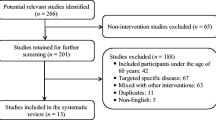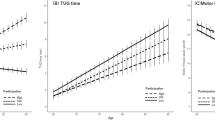Abstract
Aims
Using the reliable change index (RCI), we aimed to examine the effect of a multicomponent exercise program on the individual level.
Methods
Overall, 270 adults (mean age, 78 years) completed a multicomponent physical exercise program (strength, aerobic, gait, and balance) for 40 min, 1–2 times per week, continued up to 1 year at a daycare center. Effectiveness was assessed using grip, ankle, knee, and hip strength; Timed Up & Go (TUG); Berg Balance Scale (BBS); gait speed; and 6-min walking distance. These were measured at baseline and every 3 months thereafter. We calculated the RCI using the data between two-time points (baseline and at 3, 6, 9, or 12 months) in each participant and then calculated the mean RCI value across the participants. A paired t-test was also employed to evaluate the effect of the intervention as an average-based statistics.
Results
The highest mean RCI values were on ankle plantar-flexion strength, followed by gait speed, hip abduction strength, BBS, knee extensor strength, 6-min walk distance, grip strength, and finally TUG. Paired t-test also revealed significant improvement with moderate effect sizes for ankle plantar-flexion strength (0.504), gait speed (0.413), hip abduction strength (0.374), BBS (0.334), knee extensor strength (0.264), and 6-min walk distance (0.248). Significant but small effect size was seen on TUG (0.183).
Conclusion
The RCI is a convenient method of comparing the effect between different assessments, especially at an individual level. This index can be applied to the use of personal feedback.

Similar content being viewed by others
Data availability
The data that support the findings of this study are available on request from the corresponding author. The data are not publicly available due to privacy or ethical restrictions.
References
Ministry of Health, Labour and Welfare in Japan (2016) Long-term care insurance of Japan. https://www.mhlw.go.jp/english/policy/care-welfare/care-welfare-elderly/dl/ltcisj_e.pdf. Accessed 3 Mar 2022
Hatano E (2012) Long-term care Insurance in Japan: how physicians are involved in providing rehabilitation for the elderly. Jpn Med Assoc J 55:231–239
Li Y, Gao Y, Hu S et al (2022) Effects of multicomponent exercise on the muscle strength, muscle endurance and balance of frail older adults: a meta-analysis of randomised controlled trials. J Clin Nurs. https://doi.org/10.1111/jocn.16196
Cadore EL, Casas-Herrero A, Zambom-Ferraresi F et al (2014) Multicomponent exercises including muscle power training enhance muscle mass, power output, and functional outcomes in institutionalized frail nonagenarians. Age (Dordr) 36:773–785. https://doi.org/10.1007/s11357-013-9586-z
Patil R, Uusi-Rasi K, Tokola K et al (2015) Effects of a multimodal exercise program on physical function, falls, and injuries in older women: a 2-year community-based, randomized controlled trial. J Am Geriatr Soc 63:1306–1313. https://doi.org/10.1111/jgs.13489
Heinrich KM, Crawford DA, Langford CR et al (2021) High-intensity functional training shows promise for improving physical functioning and activity in community-dwelling older adults: a pilot study. J Geriatr Phys Ther 44:9–17. https://doi.org/10.1519/JPT.0000000000000251
Tsuji I, Tamagawa A, Nagatomi R et al (2000) Randomized controlled trial of exercise training for older people (Sendai Silver Center Trial; SSCT): study design and primary outcome. J Epidemiol 10:55–64. https://doi.org/10.2188/jea.10.55
Webber SC, Porter MM, Menec VH (2010) Mobility in older adults: a comprehensive framework. Gerontologist 50:443–450. https://doi.org/10.1093/geront/gnq013
Lacroix A, Hortobagyi T, Beurskens R et al (2017) Effects of supervised vs. unsupervised training programs on balance and muscle strength in older adults: a systematic review and meta-analysis. Sports Med 47:2341–2361. https://doi.org/10.1007/s40279-017-0747-6
Battaglia G, Bellafiore M, Bianco A et al (2010) Effects of a dynamic balance training protocol on podalic support in older women. Pilot Study Aging Clin Exp Res 22:406–411. https://doi.org/10.3275/6713
Dankel SJ, Mouser JG, Mattocks KT et al (2017) The widespread misuse of effect sizes. J Sci Med Sport 20:446–450. https://doi.org/10.1016/j.jsams.2016.10.003
Jacobson NS, Truax P (1991) Clinical significance: a statistical approach to defining meaningful change in psychotherapy research. J Consult Clin Psychol 59:12–19. https://doi.org/10.1037//0022-006x.59.1.12
Ferguson RJ, Robinson AB, Splaine M (2002) Use of the reliable change index to evaluate clinical significance in SF-36 outcomes. Qual Life Res 11:509–516. https://doi.org/10.1023/a:1016350431190
Zahra D, Hedge C (2010) The reliable change index: why isn’t it more popular in academic psychology? PsyPAG Q 76:14–19
Estrada E, Ferrer E, Pardo A (2018) Statistics for evaluating pre-post change: relation between change in the distribution center and change in the individual scores. Front Psychol 9:2696. https://doi.org/10.3389/fpsyg.2018.02696
Ieiri A, Tushima E, Ishida K et al (2015) Reliability of measurements of hip abduction strength obtained with a hand-held dynamometer. Physiother Theor Pract 31:146–152. https://doi.org/10.3109/09593985.2014.960539
Sato H, Kusayanagi K, Kondo Y et al (2018) Knee extensor strength assessed using a vertical squat and a simple geometric model to calculate joint torque: an evaluation of validity and clinical utility. Geriatr Gerontol Int 18:1125–1131. https://doi.org/10.1111/ggi.13299
Shumway-Cook A, Brauer S, Woollacott M (2000) Predicting the probability for falls in community-dwelling older adults using the timed up & go test. Phys Ther 80:896–903. https://doi.org/10.1093/ptj/80.9.896
Berg KO, Maki BE, Williams JI et al (1992) Clinical and laboratory measures of postural balance in an elderly population. Arch Phys Med Rehabil 73:1073–1080
ATS Committee on Proficiency Standards for Clinical Pulmonary Function Laboratories. ATS statement: guidelines for the six-minute walk test. Am J Respir Crit Care Med 2002. 166: 111–17. https://doi.org/10.1164/ajrccm.166.1.at1102
Wakida M, Asai T, Kubota R et al (2022) Longitudinal effects of physical exercise on health-related outcomes based on frailty status in community-dwelling older adults. Geriatr Gerontol Int 22:213–218. https://doi.org/10.1111/ggi.14346
Wakida M, Mori K, Kubota R et al (2022) Novel gait training using a dual-belt treadmill in older adults: a randomized controlled trial. Arch Gerontol Geriatr 98:104573
Ferrer R, Pardo A (2014) Clinically meaningful change: false positives in the estimation of individual change. Psychol Assess 26:370–383. https://doi.org/10.1037/a0035419
Kim HY (2015) Statistical notes for clinical researchers: effect size. Restor Dent Endod 40:328–331. https://doi.org/10.5395/rde.2015.40.4.328
Yatani K (2014) Statistical methods for HCI research. https://yatani.jp/teaching/doku.php?id=hcistats:start#non-parametric_tests. Accessed 30 Mar 2022
Wasserstein RL, Lazar NA (2016) The ASA statement on p-values: context, process, and purpose. Am Stat 70:129–133. https://doi.org/10.1080/00031305.2016.1154108
Chou CH, Hwang CL, Wu YT (2012) Effect of exercise on physical function, daily living activities, and quality of life in the frail older adults: a meta-analysis. Arch Phys Med Rehabil 93:237–244. https://doi.org/10.1016/j.apmr.2011.08.042
Raja Adnan RNE, Mat Din H, Ashari A et al (2021) Effectiveness of a community-based muscle strengthening exercise program to increase muscle strength among pre-frail older persons in Malaysia: a pilot study. Front Public Health 9:610184. https://doi.org/10.3389/fpubh.2021.610184
Acknowledgements
We thank the physiotherapists at Kansai Medical University Kori Hospital for their support in running this study. This work was supported by JSPS KAKENHI (Grant No. 21K11277).
Author information
Authors and Affiliations
Contributions
HS contributed to the study conception, design, data analysis, interpretation of data, and preparation of the manuscript. MW contributed to the study conception, material preparation, data collection, and interpretation of data. KM contributed to the study conception and interpretation of data. RK and TK contributed to the study conception, data collection, and interpretation of data. TA, YF, and JN contributed to reviewing and editing. KH contributed to the study conception, reviewing and editing, and project administration. The first draft of the manuscript was written by HS. All authors read and approved the final manuscript.
Corresponding author
Ethics declarations
Conflict of interest
On behalf of all authors, the corresponding author states that there is no conflict of interest.
Statement of human and animal rights
All procedures in this study that involved human participants were performed following the ethical standards stated in the 1964 Declaration of Helsinki and its later amendments. The study was approved by the Ethical Committee of the Kansai Medical University (No. 2018251).
Informed consent
Written informed consent was obtained from all individual participants included in the study.
Additional information
Publisher's Note
Springer Nature remains neutral with regard to jurisdictional claims in published maps and institutional affiliations.
Supplementary Information
Below is the link to the electronic supplementary material.
Rights and permissions
Springer Nature or its licensor holds exclusive rights to this article under a publishing agreement with the author(s) or other rightsholder(s); author self-archiving of the accepted manuscript version of this article is solely governed by the terms of such publishing agreement and applicable law.
About this article
Cite this article
Sato, H., Wakida, M., Kubota, R. et al. Use of the reliable change index to evaluate the effect of a multicomponent exercise program on physical functions. Aging Clin Exp Res 34, 3033–3039 (2022). https://doi.org/10.1007/s40520-022-02241-6
Received:
Accepted:
Published:
Issue Date:
DOI: https://doi.org/10.1007/s40520-022-02241-6




